![]()
![]()
![]()
Use LEFT and RIGHT arrow keys to navigate between flashcards;
Use UP and DOWN arrow keys to flip the card;
H to show hint;
A reads text to speech;
208 Cards in this Set
- Front
- Back
|
1. Leadership |
x
|
|
|
Leadership |
- Leadership is the ability to influence a group of individuals to achieve a common goal. - Leadership is simply “a process of influence.” |
|
|
Eliminate-Reduce-Raise-Create (ERRC) Grid |
ERRC Grid developed by Kim & Mauborgne (2005) is a simple matrix like tool that drives to focus simultaneously on eliminating and reducing, as well as raising and creating while unlocking a new blue ocean.
1. Which factors that the leadership industry takes for granted should be eliminated?
2. Which factors should be reduced? 3. Which factors should be raised? 4. Which factors should be created that the leadership industry has never offered? |
|
|
Creating ERRC GridsLeadership industry should: |
Eliminate: Attitude, Jealously, corruption Reduce: Reduce the idea that everyone knows what you know, self-interest Raise: Team work, Efficiency, Measurement of Performance Create: More strategic thinking, Gender balance, Judgement free environment |
|
|
Components Central to the Phenomenon of Leadership |
1. Leadership 2. Leaders
|
|
|
1. Leadership |
- Is a process - Involves influence - Occurs within a group context - Attends to common goals |
|
|
2. Leaders |
- And followers are involved together - And followers need each other - Often initiate and maintain the relationship - Are not above or better than followers |
|
|
|
organizations have done a poor job of selecting the right people for leadership roles |
|
|
Indicators of Effective Leadership |
High group performance Follower satisfaction Improved group processes Career success of leader |
|
|
The “romance of leadership” |
- There is a significant distinction between leadership prescriptions and actual implementation. - No credentials, experience, or even knowledge required to be a leader - Measure and hold people accountable for workplace outcome |
|
|
The Different Views of Leadership |
1. Trait Definition of Leadership: Leader - Leadership (Height, Intelligence, Extroversion, Fluency, Other Traits) - Followers 2. Process Definition of Leadership: Leader - Leadership (Interaction; both ways) - Followers |
|
|
Assigned vs. Emergent Leadership |
Assigned: Leadership based on occupying a position within an organization (Team Leaders, Plant managers, Department heads, Directors)
Emergent: An individual perceived by others as the most influential member of a group or organization regardless of the individual’s title (Emerges over time through communication behaviors - Verbal Involvement, Being informed, Seeking others' opinions, Being firm but not rigid; Affected by personality and gender |
|
|
Leadership & Power |
- Position Power: derived from office or rank in an organization (Ex. Legitimate, Reward, Coercive, Information) - Personal Power: is influence derived from being seen as likable & knowledgeable (Ex. Referent, Expert) |
|
|
Six Bases of Power |
1. Referent Power: Based on followers' identification and liking for the leader. A teach who is adored by students has referent power. 2. Expert Power: Based on followers' perceptions of the leader's competence. A tour guide who is knowledgeable about a foreign country has expert power. 3. Legitimate Power: Associated with having status or formal job authority. A judge who administers sentences in the courtroom exhibits legitimate power. 4. Reward Power: Derived from having the capacity to provide rewards to others. A supervisor who gives rewards to employees who work hard is using reward power. 5. Coercive Power: Derived from having the capacity to penalize or punish others. A coach who sits players on the bench for being late to practice is using coercive power. 6. Information Power: Derived from possessing knowledge that others want or need. A boss who has information regarding new criteria to decide employee promotion eligibility has information power. |
|
|
Leadership & Coercion |
Coercion Involves: - Use of force to effect change - Influencing others to do something by manipulating rewards and penalties in the work environment - Use of threats, punishments, & negative rewards
|
|
|
Examples of Coercive Leaders |
Adolf Hitler Jim Jones Taliban leaders
Power & restraint used to force followers to engage in extreme behavior
|
|
|
Shift in Leadership Power, Kellerman (2012) |
- Power no longer the domain of leaders - Followers demand more from leaders - Access to technology has empowered followers - Leaders more transparent - Decline in respect for leaders - Leadership as social contract between leaders and followers |
|
|
Leadership & Management, Kotter (1990) |
Management Activities (Produces order and Consistency) - Planning and Budgeting - Organizing and Staffing - Controlling and Problem Solving
Leadership Activities (Produces change and movement) - Establishing Direction - Aligning People - Motivating/Inspiring
Major activities of management & leadership are played out differently; BUT, both are essential for an organization to prosper
|
|
|
Leadership & Management Zaleznik (1977) |
Managers (Unidirectional Authority) - Are Reactive - Prefer to work with people solving - Have lower emotional involvement
Leaders (Multidirectional Influence) - Are emotionally active & involved - Shape ideas over responding to them - Act to expand available options - Change the way people think about what is possible
Leading as an influence relationship and managing as an authority relationship |
|
|
2. Trait Approachto Leadership |
x |
|
|
“Great Man” Theories (early 1900s) |
- Trait Approach: one of the first systematic attempts to study leadership
- Theories that consider personality, social, physical,or intellectual traits to differentiate leaders from non-leaders |
|
|
Major Leadership Traits |
- Intelligence: Verbal, perceptual, and reasoning capabilities. Ex. Steve Jobs - Self-Confidence: Certainty about one's competencies and skills. Ex. Steve Jobs - Determination: Desire to get the job done(i.e., initiative, persistence, drive). Ex. Dr. Paul Farmer - Integrity: The quality of honesty and trust worthiness. Ex. Mandela - Sociability: Leader’s inclination to seek out pleasant social relationships. |
|
|
5-FactorPersonality Model & Leadership (Big Five Personality Factors) |
1. Neuroticism: The tendency to be depressed, anxious, insecure, vulnerable, and hostile
2. Extraversion: The tendency to be sociable and assertive and to have positive energy 3. Openness: The tendency to be informed, creative, insightful, and curious 4. Agreeableness: The tendency to be accepting, conforming, trusting, and nurturing 5. Conscientiousness: the tendency to be thorough, organized, controlled, dependable, and decisive |
|
|
5-Factor Personality Model & Leadership Results |
Results: a strong relationship between personality traits and leadership 1. Extraversion: factor most strongly associated with leadership (Most important trait of effective leaders) 2. Conscientiousness: second most related factor 3. Openness: next most related 4. Low Neuroticism 5. Agreeableness: only weakly related to leadership |
|
|
Leadership and other personality traits |
- Modesty - Honesty - Trust |
|
|
Modesty: why leaders aren't? |
- Although modesty may be valued in the leadership literature, self promotion, narcissism and assertiveness seem to be produce better career results in the real world. - Modesty works for those who already have a well established position and reputation. For these people modesty is seen as charming rather than indicative of insecurity and competence. |
|
|
The opposite of “modesty” is“narcissism”. |
- Although modesty is desired,immodest traits like narcissism are common in the workplace. - Narcissistic people get leadership positions as they are more noteworthy and take more risk, while modesty is commonly ignored (Pfeffer, 2015). |
|
|
Narcissism |
- A grandiose sense of self importance, fantasies of unlimited success or power. - The tendency to be arrogant, have a grandiose sense of importance, require excessive admiration, and have a sense of entitlement. - Narcissists tend to think that they are better leaders than their colleagues; but, their supervisors tend to rate them as worse. - They are effective at becoming celebrities |
|
|
What do you think about narcissistic leaders? |
- Leadership involves uncertainty and immodesty creates positive first impression and then confirmation bias. - Immodesty and self promotion helps people being noticed and getting remembered - Narcissism help individuals to “self nominate”themselves. - Narcissists are more likely to be engaged in the self-fulfillment prophecy |
|
|
Honesty Should Leaders Tell the Truth – and Do They? |
In some industries, medicine for example, telling the truth is imperative. However, in other industries, lying is much more prevalent. |
|
|
Trust: Where Did It Go, and Why? B |
- Trust has the ability to build the foundation of successful and healthy relationships, and is a key factor in employee performance - The concept of trust goes hand in hand with truth. If followers are able to believe that what their leader is saying is the truth, they develop trust in them. - A generally accepted prescription is that leaders should be trustful, yet it is rare in reality. |
|
|
Emotional Intelligence & Leadership |
1. Ability to perceive and: apply emotions to life’s tasks; reason/understand emotions; express emotions; use emotions to facilitate thinking; manage emotions within oneself and relationships 2. Underlying Premise: people who are more sensitive to their emotions & their impact on others will be more effective leaders |
|
|
Model of Emotional Intelligence |
1. Relationship Management: Managing other people's emotions
2. Social Awareness: Perceiving and understanding the meaning of others' emotions 3. Self-management: Managing our own emotions 4. Self-Awareness: perceiving and understanding the meaning of your own emotions |
|
|
Different Ways to Measure EQ |
MSCEIT: EQ as a set of mental abilities; to perceive, facilitate,understand, and manage emotion Goleman (1995, 1998): EQ as a set of personal and social competencies; self-awareness, confidence,self-regulation, conscientiousness, and motivation Shankman & Allen (2002): EQ as awareness of three aspects of leadership; context, self, and others |
|
|
How Does the Trait Approach Work? |
Leader: Focuses exclusively on leader (What traits leaders exhibit; Who has these traits) Personality Assessments: Organizations use personality assessments to find "right" people (Assumption: will increase organizational effectiveness; specify characteristics/traits for specific positions - Personality assessment measures for "fit" / Instruments: LTQ, Myers-Briggs) |
|
|
Strengths of the Trait Approach |
- Intuitively appealing: Perception that leaders are different in that they possess special traits & People“need” to view leaders as gifted - Credibility due to a century of research support - Highlights leadership component in the leadership process: Deeper level understanding of how leader/personality is related to leadership process - Provides bench marks for what to look for in a leader |
|
|
Criticisms of the Trait Approach |
- Fails to delimit a definitive list of leadershiptraits: Endlesslists have emerged - Doesn’t take into account situational effects: Leaders in one situation may not be leaders in another situation - List of most important leadership traits is highly subjective: Much subjective experience & observations serve as basis for identified leadership traits - Research fails to look at traits in relationship to leadership outcomes - Not useful for training & development |
|
|
Application |
- Can be used by managers to assess where they stand within their organization and what is needed to strengthen their position - Provides direction as to which traits are good to have if one aspires to a leadership position - - Through various tests and questionnaires, individuals can determine whether they have the select leadership traits and can pinpoint their strengths and weaknesses |
|
|
3. Skills approach to leadership |
x |
|
|
Skills Approach Description |
Perspective: - Leader-centered perspective - Emphasis on skills and abilities that can be learned and developed Definition: - Leadership skills: The ability to use one’s knowledge and competencies to accomplish a set of goals and objectives |
|
|
Three-Skill Approach (Katz, 1955) |
1. Technical Skill 2. Human Skill 3. Conceptual Skill |
|
|
Basic Administrative Skills – Katz (1955) |
Leaders need all three skills, but relative importance changes based on level of management |
|
|
Three-Skill Approach Rankings |
Top Management: 1. Human & Conceptual 2. Technical
Middle Management: EQUAL: Human, Conceptual & Human Supervisory Management: 1. Technical & Human 2. Conceptual |
|
|
Technical Skill |
- Having knowledge about and being proficient in a specific type of work or activity: Specialized competencies, Analytical ability, Use of appropriate tools and techniques - Technical skills involve hands-on ability with a product orprocess - Most important at lower levels of management |
|
|
Human Skill |
Having knowledge about and being able to work with people. - Being aware of one’s own perspective and others’ perspectives at the same time - Assisting group members in working cooperatively to achieve common goals - Creating an atmosphere of trust and empowerment of members - Importantat all levels of the organization |
|
|
Conceptual Skill |
The ability to do the mental work of shaping meaning of organizational policy or issues (what company stands for and where it’s going): - Workseasily with abstraction and hypothetical notions - Central to creating and articulating a vision and strategic plan for an organization - Most important at top management levels |
|
|
Skills Model Description |
Perspective: - Research studies (1990s) goal: to identify the leadership factors that create exemplary job performance in an organization - Emphasizes the capabilities that make effective leadership possible rather than what leaders do Skills-Based Model of Leadership - Capability model: Examines relationship between a leader’s knowledge & skills & the leader’s performance. Suggests many people have the potential for leadership |
|
|
Three Components of the Skills Model |
1. Individual Attributes: General Cognitive Ability, Crystallized Cognitive Ability, Motivation, Personality 2. Competencies: Problem-Solving Skills, Social Judgment Skills, Knowledge 3. Leadership Outcomes: Effective Problem Solving, Performance |
|
|
Individual Attributes |
1. General Cognitive Ability: Person's Intelligence (Perceptual Processing; Information Processing; General Reasoning; Creative & Divergent thinking; memory) 2. Crystallized Cognitive Ability: Intellectual ability learned or acquired over time 3. Motivation: Three aspects of motivation (Willingness; Dominance; Social Good) 4. Personality: Any characteristic that helps people cope with complex organizational situations is probably related to leader performance |
|
|
Competencies Skills |
1. Problem Solving: Creative ability to solve new/unusual, ill-defined organizational problems 2. Social Judgment: Capacity to understand people and social systems (Perspective taking; Social perceptiveness; Behavioral flexibility; Social performance) 3. Knowledge: The accumulation of information & the mental structures to organize the information |
|
|
Leadership Outcomes |
1. Problem Solving: Criteria= originality & quality of solutions to problem situations – good problem solving involves creating solutions that are: - Logical; Effective; Unique; Go beyond given information 2. Performance: Degree to which a leader has successfully performed his/her assigned duties |
|
|
Skills Model of Leadership |

|
|
|
Career Experiences |
1. Challenging Assignments
2. Mentoring 3. Appropriate Training 4. Hands-on Experience with Novelty - Experience gained during career influences leader’s knowledge & skills to solve complex problems - Leaders learn and develop higher levels of conceptual capacity if they progressively confront more complex and long-term problems as they ascend the organizational hierarchy |
|
|
How Does the Skills Approach Work? |
1. Focus: Focus is primarily descriptive – it describes leadership from skills perspective; Provides structure for understanding the nature of effective leadership
2. Principal Research Perspectives: - Katz (1955)suggests importance of particular leadership skills varies depending where leaders reside in management hierarchy - Mumford,Campion, & Morgeson,(2007)suggest higher levels of all skills needed at higher levels of hierarchy - Mumford,Zaccaro,Harding et al. (2000)suggest leadership outcomes are direct result of leader’s skilled competency in problem solving, social judgment, & knowledge |
|
|
Strengths of the Skills Approach |
- First approach to conceptualize and create a structure of the process of leadership around skills - Describing leadership in terms of skills makes leadership available to everyone - Provides an expansive view of leadership that incorporates wide variety of components (i.e., problem-solving skills, social judgment skills) - Provides a structure consistent with leadership education programs |
|
|
Criticisms of the Skills Approach |
- Breadth of the skills approach appears to extend beyond the boundaries ofl eadership, making it more general, less precise - Weak in predictive value; does not explain how skills lead to effective leadership performance - Skills model includes individual attributes that are trait-like |
|
|
Application of the Skills Approach |
- The Skills Approach provides away to define the skills of a leader - It is applicable to leaders atall levels within the organization - The skills inventory can provide insights into the individual’s leadership competencies - Test scores allow leaders to learn about areas in which they may wish to seek further training |
|
|
4. Behavioural approach to leadership |
x |
|
|
Behavioural Theories of Leadership |
Theories proposing that specific behaviors differentiate leaders from non-leaders Differences between theories of leadership: - Trait Theory - Skills Approach - Behavioral Theory |
|
|
Trait Theory |
leadership is inherent, so we must identify the leader based on his or her traits |
|
|
Skills approach: |
Emphasis on skills and abilities that can be learned and developed |
|
|
Behavioral theory |
leadership is a skill set and behaviors which can be taught to anyone, so we must identify the proper behaviors to teach potential leaderss |
|
|
Behavioral Approach Description |
Perspective: Emphasizes the behavior of the leader; Focuses exclusively on what leaders do and how they act Definition: Composedof two general kinds of Behaviors - 1. Task Behaviors 2. Relationship behaviors |
|
|
Task behaviors |
Facilitate goal accomplishment: Help group members achieve objectives |
|
|
Relationship behaviors |
Help subordinates feel comfortable with themselves, each other, and the situation |
|
|
Important Behavioral Studies |
1. Ohio State University (Most widely used leadership assessment instrument) 2. University of Michigan |
|
|
Ohio State University |
Found two key dimensions of leader behavior: 1. Initiating structure: Leaders provide structure for subordinates (Task behaviors: organizing work, giving structure to the work context, defining role responsibility, scheduling work activities ) 2. Consideration: Leaders nurture subordinates that reflect trust and respect (Relationship behaviors –building friendship, respect, trust, & liking between leaders & followers) |
|
|
Universityof Michigan |
Also found two key dimensions ofleader behavior: 1. Employee-oriented: Strong human relations emphasis 2. Production-oriented: emphasizes the technical aspects of the job |
|
|
Task-oriented behaviors are more important for leadership |
No conflict of interest More focus on the job Less distractions Less inefficient Helps companies meets their goal (makes more profits) |
|
|
Relationship-oriented behaviors are behaviour more important for leadership |
Interpersonal skills with the team, will give others confidence to talk to the manger about problems and give good advice If employees are not engage, then employees will not go beyond the minimum expectations (no creativity, no innovation) |
|
|
Blake& Mouton’s Grid |
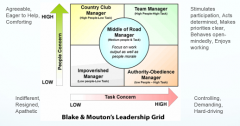
|
|
|
Fiedler leadership Model |
Least preferred co-worker (LPC) questionnaire determined whether individuals were primarily interested in: - Relationship-oriented: good personal relations with co-workers - Task-oriented: Production and productivity |
|
|
Fiedler’s Leadership Style as Indicated by Least Preferred Co-Worker (LPC) Scale |
The Least Preferred Coworker (LPC): is the person a leader has least preferred to work with over his or her career.This is used to classify leadership style (High and Low LPC) |
|
|
Interpreting LPC Score |
Ascored greater than 76 = High LPC; Relationship-Oriented Ascored less than 67= Low LPC task-oriented; Task-Oriented Ascore between 68-75you are a mixture of both |
|
|
Fiedler’s Leadership Model |
Leadership style is stable: based on personality Best style depends on situational control Theory has problems, but uniquely points out inflexibility of leadership style Fiedler assumed that an individual’s leadership style is fixed. |
|
|
Historical Perspective Blake & Mouton’s Managerial Leadership Grid |
Development: Developed in early 1960s; Used extensively in organizational training & development Purpose: Designedto explain how leaders helporganizations to reach their purposes Two factors: 1. Concern for production: How aleader is concerned with achieving organizational tasks 2. Concern for people: How aleader attends to the members of the organization who are trying to achieve its goals |
|
|
Blake & Mouton’s Grid |

Leadership Grid Components: - Authority-Compliance (9,1) - Country Club Management (1,9) - Impoverished Management (1,1) - Middle-of-the-Road Management (5,5) - Team Management (9,9) - Paternalism/Maternalism(1,9; 9,1) - Opportunism |
|
|
Authority-Compliance(9,1) |
Definition: Efficiency in operations results from arranging conditions of work such that human interference is minimal Role Focus: - Heavy emphasis on task and job requirements and less emphasis on people - Communicating with subordinates mainly for task instructions - Results driven –people regarded as tools to that end - 9,1 leaders– seen as controlling, demanding,hard-driving, & overpowering |
|
|
CountryClub (1,9) |
Definition: Thoughtful attention to the needs of people leads to a comfortable, friendly organizational atmosphere and work tempo Role Focus - Low concern for task accomplishment coupled with high concern for interpersonal relationships - Deemphasizes production;leaders stress the attitudes and feelings of people - 1,9 leaders: try to create a positive climate by being agreeable, eager to help, comforting, noncontroversial |
|
|
Impoverished (1,1) |
Definition: Minimal effort exerted to get work done is appropriate to sustain organizational membership Role Focus - Leader unconcerned with both task and interpersonal relationships - Going through the motions, but uninvolved and withdrawn - 1,1 leaders: have little contact with followers and are described as indifferent, noncommittal, resigned, and apathetic |
|
|
Middle-of-the-Road (5,5) |
Definition: Adequate organizational performance possible through balancing the necessity of getting work done while maintaining satisfactory morale Role Focus - Leaders who are compromisers; have intermediate concern for task and people who do task - To achieve equilibrium, leader avoids conflict while emphasizing moderate levels of production and interpersonal relationships - 5,5 leader: described as expedient; prefers the middle ground; soft-pedals disagreement; swallows convictions in the interest of “progress” |
|
|
Team (9,9) |
Definition: Work accomplished through committed people; interdependence via a “common stake” in the organization’s purpose, which leads to relationships of trust and respect Role Focus - Strong emphasis on both tasks and interpersonal relationships - Promotes high degree of participation & teamwork, satisfies basic need of employee to be involved & committed to their work - 9,9 leader: stimulates participation, acts determined, makes priorities clear, follows through, behaves open-mindedly and enjoys working |
|
|
Opportunism |
Definition: People adapt and shift to any grid style needed to gain maximum advantage Role Focus: - Performance occurs according to a system of selfish gain - Leader uses any combination of the basic five styles for the purpose of personal advancement - Maybe seen as ruthless and cunning - May also be seen as adaptable and strategic Leaders usually have a dominant grid style used in most situations and a backup style that is reverted to when under pressure |
|
|
How Does the Behavioral Approach Work? |
Focus: Primarily a framework for assessing leadership as behavior with a task and relationship dimension Overall Scope: Offers a general means of assessing the behaviors of leaders |
|
|
Strengthsof the Behavioral Approach |
Behavioral approach marked a major shift in leadership research from exclusively trait focused to include behaviors and actions of leaders Broad range of studies on leadership style validates and gives credibility to the basic tenets of the approach At conceptual level, a leader’s style is composed of two major types of behaviors: task and relationship The behavioral approach is heuristic: leaders can learn a lot about themselves and how they come across to others by trying to see their behaviors in light of the task and relationship dimensions |
|
|
Criticisms of the Behavioral Approach |
Research has not adequately demonstrated how leaders’ styles are associated with performance outcomes No universal style of leadership that could be effective in almost every situation Implies that the most effective leadership style is High-High style (i.e., high task/high relationship); research finding support is limited |
|
|
Application of the Behavioral Approach |
Many leadership training and development programs are designed along the lines of the style approach. By assessing their own style,managers can determine how they are perceived by others and how they could change their behaviors to become more effective. The style approach applies to nearly everything a leader does. |
|
|
Model of Emotional Intelligence |
Relationship Management: managing other people’s emotions Social Awareness: perceiving and understanding the meaning of others’ emotions Self-management: Managing our own emotions Self-awareness: perceiving and understanding the meaning of your own emotions |
|
|
5. Situational Approach to Leadership |
x |
|
|
Contingency Theories: Does the Situation Matter? |
contingency theories are “if–then”theories: If the situation is ____, then the appropriate leadership behaviour is ____. Different situations demand different kinds of leadership Proposes that different leadership styles used at different times depending on the circumstance. Effective leadership depends upon the degree of fit between the leader’s style and various factors in the particular situation. |
|
|
Situational Approach Description (Hersey & Blanchard, 1969) |
Perspective: Focuses on leadership in situations Emphasizes adapting style: different situations demand different kinds of leadership Used extensively in organizational leadership training and development “Leaders match their style to the competence and commitment of subordinates” |
|
|
Hersey and Blanchard’s Situational Leadership |
A model that focuses on follower “readiness”Followers can accept or reject the leader Effectiveness depends on the followers’ response to the leader’s actions “Readiness” is the extent to which people have the ability and willingness to accomplish a specific task Apaternal model: As the child matures, the adultreleases more and more control over the situation As the workers become more ready,the leader becomes more laissez-faire Anintuitive model that does not get much support from the research findings |
|
|
Situational Approach Description, cont’d (Hersey & Blanchard, 1969) |
Definition: Composed of both a directive dimension & supportive dimension: Each dimension must be applied appropriately in a given situation Leaders evaluate employees to assess their competence and commitment to perform a given task |
|
|
Leadership Styles |
Definition: Leadership style - the behavior pattern of an individual who attempts to influence others It includes both: Directive (task) behaviors Supportive (relationship) behaviors |
|
|
Leadership Styles Directive behaviors |
Directive behaviors: Help group members in goal achievement via one-way communicationthrough: Giving directions Establishinggoals & how to achieve them Methods of evaluation & time lines Defining roles |
|
|
Leadership Styles Supportive behaviors |
Supportive behaviors: Assist group members via two-way communication infeeling comfortable with themselves, co-workers, and situation Asking for input Problem solving Praising, listening |
|
|
Development level of Employees |
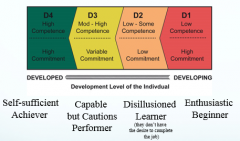
|
|
|
Hersey & Blanchard’s Situational Leadership |

|
|
|
S1- Directing Style |
Leader focuses communication on goal achievement Spends LESS time using supportive behaviors |
|
|
S2- Coaching Style |
Leader focuses communication on BOTH goal achievement and supporting subordinates’socioemotional needs Requires leader involvement through encouragement and asking subordinate input |
|
|
S3- Supporting Style |
Leader does NOT focus solely on goals; uses supportive behaviors to bring out employee skills in accomplishing tasks Leader delegates day-to-day decision-making control but is available to facilitate problem solving |
|
|
What is the right balance of support and praise? How much is too much? |
When you too much praise someone nonstop, you are making their actions and performance yours. So they’re looking over their shoulder and not owning their work.(Carol Dweck, professor of psychology at Stanford University, 2016) When we gave individuals lots of praise then discontinued it, they either lost motivation or they did a variety of strange and distorted things to get the approval back. |
|
|
S4- Delegating Style |
Leaderoffers LESS task input and social support; facilitates subordinates’ confidence and motivation in relation to the task Leader lessens involvement in planning, control of details, and goal clarification Gives subordinates control and refrains from intervention and unneeded social support |
|
|
How Does the Situational Approach work? |
Focus: Assumes that subordinates vacillate along the developmental continuum of competence and commitment Leader effectiveness depends on - assessing subordinate’s developmental position, and - adapting his/her leadership style to match subordinate developmental level “The situational approach requires leaders to demonstrate a strong degree of flexibility.” |
|
|
How Does The Situational Approach Work? |
Using SLII®model – Inany given situation the leader has two tasks: 1) 1st Task Diagnose the Situation 2) 2nd Task Adapt Leadership Style |
|
|
1st Task Diagnose the Situation |
Diagnose the Situation: Identify the developmental level of employee Ask questions like: - What is the task subordinates are being asked to perform? - How complicated is it? - What is their skill set? - Do they have the desire to complete the job? |
|
|
2nd Task Adapt Leadership Style |
Adapt leadership Style: To prescribed Leadership style in the SLII model - Leadership style must correspond to the employee’s development level |
|
|
Strengths of the Situational Approach |
Marketplace approval Situational Leadership® is perceived as providing a credible model for training employees to become effective leaders. Practicality.Situational Leadership is a straightforward approach that is easily understood and applied in a variety of settings. Prescriptive value. Situational Leadership®clearly outlines what you should and should not do in various settings. Leader flexibility. Situational Leadership® stresses that effective leaders are those who can change their styles based on task requirements and subordinate needs. Differential treatment. Situational Leadership is based on the premise that leaders need to treat each subordinate according to his/her unique needs. |
|
|
Criticisms of the Situational Approach |
Lack of an empirical foundation raises theoretical considerations regarding the validity of the approach. Further research is required to determine how commitment and competence are conceptualized for each developmental level. Conceptualization of commitment itself and why it varies is very unclear. Replication studies fail to support basic prescriptions of the Situational Leadership® model. Does not account for howparticular demographics influence the leader-subordinate prescriptions of themodel Fails to adequately address theissue of one-to-one versus group leadership in an organizational setting Questionnaires are biased infavor of SituationalLeadership |
|
|
Applicationof the Situational Approach |
Often used in consulting because it’s easy to conceptualize and apply Straightforward nature makes itpractical for managers to apply Breadth of situational approach facilitates its applicability in virtually all types of organizations and levels of management in organizations |
|
|
5. Leadership development |
x |
|
|
Leadership development |
Developing effective leadership by using a consistent talent management program at all levels. To identify, attract, fill, and retain corporate leadership talent, companies need leadership development programs focused on hiring strategies, employee development, and career and succession planning. |
|
|
Elements of Leadership Development Programs |
Assessments, to evaluate leadership capabilities both internally and externally Performance management, to monitor and make course corrections in developing leaders Career planning, to enable employees to understand their leadership options and set development goals Development, to create a road map to fill skill gaps Succession planning, to avoid future leadership gaps Recruitment, to source leadership talent |
|
|
Leadership development and succession planning? |
Systematic process for identifying, assessing and developing staff Vital to future success of an organization Strategic Planning for Human Capital Investment in your future leaders Succession Planning is proactive and not reactive Sustainability that creates motivated and capable employees |
|
|
Succession Planning: Key Elements |
Assessmentof Key Positions Identification of Key Talent Assessment of Key Talent Generation of Development Plans Development of Monitoring & Review |
|
|
Succession Planning: Key Elements |
Assessment of Key Positions: What are the competencies and experiences needed to qualify for each key position?
Identification of Key Talent: Typically people at the top two levels of the organization and high potential employees one level below; Identified by their management’s assessment of their performance and potential for advancement Assessment of Key Talent: For each person on the radar screen, primary development needs are identified focusing on what they need in order to be ready for the next level. Generation of Development Plans: A development plan is prepared for how we will help the person develop over the next year. Development Monitoring &Review: Annual or semi-annual succession planning review is held to review progress of key talent and to refresh or revise their development plan. |
|
|
Leadership development Process |
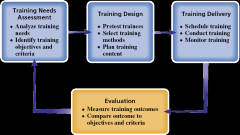
|
|
|
Learning Principles |

|
|
|
Learning Pyramid |
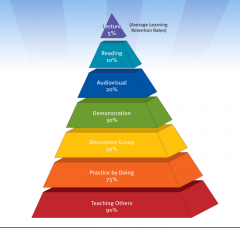
|
|
|
Choosing a Development Approach |
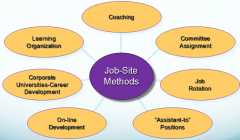
|
|
|
Choosing a Development Approach |
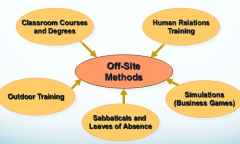
|
|
|
Example: Coaching |
Identify an opportunity to help someone expand on his or her skills, knowledge and abilities Confirm that the person is ready for coaching. Ask questions and offer information to help clarify the situation. Help the person identify possible actions. Gain agreement on a course of action. Offer your support. |
|
|
Advantages and Disadvantages ofMajor Development Approaches |
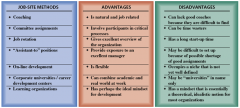
|
|
|
Advantages and Disadvantages ofMajor Development Approaches |

|
|
|
Leadership Development Toolbox |
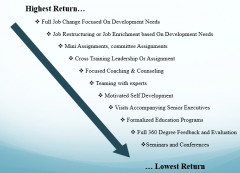
|
|
|
Training Evaluation Criteriam |
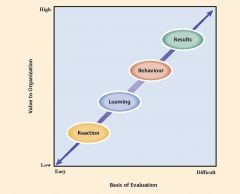
Reaction (such as evaluation form): does not get a lot of value or info Learning(ex. Exams): you write then forget; it is important to engage people and make sure they understand the application Behavior: Results(ex. Sales goals): by repeating a goal and afterwards the results match that then it is good |
|
|
Some Typical Costs and Benefits of Training
|

|
|
|
Individual leadership development |

|
|
|
Individual Leadership Development |
Develop relevant skills Maintain self-awareness: Commit to life-long learning and active self-development; Doing is learning: Actively seek leadership opportunities to demonstrate/develop leadership traits and skills Recognize that a strength can become a weakness: A strength in one situation can become a weakness in another situation, one must adapt to every situation; Any strength taken to the extreme can become a weakness, even when the situation has not changed (Confidence becomes arrogance, innovation becomes recklessness, decisiveness becomes rashness, open-mindedness becomes lack of focus) Compensate for weakness (Recruit team members who have strengths that complement your weaknesses; Delegate work according to the strengths of each team member; Sometimes,a committee of varied expertise can better manage a task than one skilled individual) |
|
|
6. Path-Goal Theory |
x |
|
|
Differences between theories of leadership: |
1. Trait theory: leadershipis inherent, so we must identify the leader based on his or her traits 2. Skills approach: Emphasis on skills and abilities that can be learned and developed(technical, human, and conceptual skills; Dr Wood Case) 3. Behavioral theory:specific behaviors differentiate leaders from non-leaders. leadership is a skill set and behaviors which can be taught to anyone. (task and relationship oriented behavior) 4. Situational approach: Emphasizes adapting style - different situations demand different kinds of leadership.Leaders match their style to the competence and commitment of subordinates (D1,D2, D3, D4) 5. Path-goal theory: Emphasizes the relationship between the leader’s style, the characteristics of the followers, the work setting, and employee motivation (directive approach; need to consider characteristics of subordinates and task characteristics) Situational/Path-goal:Different situations may call for different leadership behavior |
|
|
Path–Goal Theory (House, 1971) |
- Path–Goal Theory Perspective - Conditions of Leadership Motivation - Leader Behaviors &Follower Characteristics - Task Characteristics - How Does PGT Work? |
|
|
Definition of Path-Goal Theory |
- Path–goal theory centers on how leaders motivate followers to accomplish designated goals - Emphasizes the relationship between the leader’s style, the characteristics of the followers, and the work setting |
|
|
Perspective of Path-Goal Theory |
- Goal: To enhance employee performance and satisfaction by focusing on employee motivation - Motivational Principles (based on Expectancy Theory): Followers will be motivated if they believe - they are capable of performing their work - that their efforts will result in a certain out come - that the payoffs for doing their work are worth while |
|
|
Expectancy Theory |
1) Expectancy: belief that effort leads to performance (Effort-Performance Relationship) 2) Instrumentality: belief that performance is related to rewards (Performance-Reward Relationship) 3) Valence: value or importance placed on a particular reward (Rewards-Personal Goals Relationship) Effort = Expectancy х Instrumentalityх Valence |
|
|
Path-Goal Guidelines to Be Effective |
A leader’s behavior is acceptable to subordinates insofar as they view it as a source of either immediate or future satisfaction Follow expectancy theory. Determine the outcomes subordinates want. (e.g., good pay, job security,interesting work, and autonomy to do one’s job, etc.) Reward individuals with their desired outcomes when they perform well. Be clear with expectations. Let individuals know what they need to do to receive rewards (the path to the goal). Remove barriers that prevent high performance. Express confidence that individuals have the ability to perform well. |
|
|
Challenge to Leader |
Use a leadership style that best meets followers’ motivational needs choose behaviors that complement or supplement what is missing in the work setting enhance goal attainment by providing information or rewards provide followers with the elements they need to reach their goals |
|
|
Conditionsof Leadership Motivation |
Leadership generates motivation when It increases the number and kinds of payoffs followers receive from their work Makes the path to the goal clear and easy to travel through with coaching and direction Removes obstacles and road blocks to attaining the goal Makes the work itself more personally satisfying |
|
|
The Basic Idea Behind Path-Goal Theory |
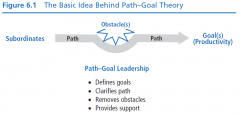
|
|
|
Major Components of Path-Goal Theory |
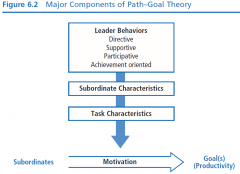
|
|
|
Directive Leadership |
Leader who gives followers task instruction including: - What is expected of them - How task is to be done - Timeline for task completion - Clear standards of performance - Clear rules & regulations |
|
|
Supportive Leadership |
Leader who is friendly and approachable: - Attending to well-being & human needs of followers - Using supportive behavior to make work environment pleasant - Treating followers as equals & giving them respect for their status |
|
|
Participative Leadership |
Leader who invites followers toshare in the decision making: - Consults with followers - Seeks their ideas & opinions - Integrates their input into group/organizational decisions |
|
|
Achievement-Oriented Leadership |
Leader who challenges followersto perform work at the highest level possible: - Establishesa high standard of excellence for subordinates - Seeks continuous improvement - Demonstrates a high degree of confidence in followers’ ability to establish & achieve challenging goals |
|
|
Effects of Goals on Performance |
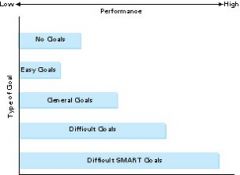
|
|
|
Expectancy Theory |
- A leader’s behavior is acceptable to subordinates insofar as they view it as a source of either immediate or future satisfaction - Expectancy:belief that effort leads to performance (Effort-Performance Relationship) People tend to be more motivated if they believe that increasing effort will result in higher performance - Instrumentality:belief that performance is related to rewards (Performance-Reward Relationship) - Valence:value or importance placed on a particular reward (Rewards-Personal goals Relationship) Effort= Expectancy x Instrumentality x Valence |
|
|
Follower Characteristics: Need for affiliation |
Strong need for affiliation - Friendly and concerned leadership is a source of satisfaction - Supportive Leadership |
|
|
Follower Characteristics: Preference for Structure |
Preference for Structure - Dogmatic & authoritarian: Leadership provides psychological structure, task clarity, & greater sense ofcertainty in work setting - Directive Leadership |
|
|
Follower Characteristics: Desire for Control |
Internal Focus of control: - Leadership thatallows followers to feel in charge of their work & makes them an integralpart of the decision-making process - Participative Leadership External focus of control - Leadership thatparallels followers’ feelings that outside forces control their circumstances - Directive Leadership |
|
|
Follower Characteristics: Self-efficacy |
Perception of their own ability –specific task: - As perceptionof ability and competence goes up, need for highly directive leadership goes down - Directive leadership may become redundant, possibly excessively controlling |
|
|
Task Characteristics: Task Situations Requiring Leader Involvement |
Task Situations Requiring Leader Involvement Unclear and ambiguous: Leader needs to provide structure Highly repetitive: Leader needs to provide support to maintain follower motivation Weak formal authority: If formal authority system is weak, the leader needs to assist followers by making rules and work requirements clear Non-supportive/weak group norms: Leader needs to help build cohesiveness and role responsibility |
|
|
Task Characteristics: Obstacles |
Obstacles Anything in the work setting that gets in the way of followers Theycreate excessive uncertainties, frustrations, or threats for followers Leader’sresponsibility is to help followers by Removing the obstacles Helping followers around them Assisting with obstacles will increase Followers’ expectations to complete the task Their sense of job satisfaction |
|
|
Path-Goal Theory |
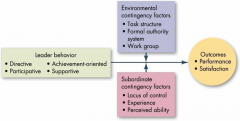
|
|
|
How Does the Path–Goal Theory Work? |
Focus Path–goal theory is a complex but also pragmatic approach Leaders should choose a leadership style that best fits the needs of followers and their work Overall Scope Path–goal theory provides a set of assumptions about how different leadership styles will interact with follower characteristics and the work situation to affect employee motivation |
|
|
How Does the Path–Goal Theory Work? |
- The leader’s job is to help followers reach their goals by directing, guiding, and coaching them along the way - Leaders must evaluate task and follower characteristics and adapt leadership style to these - The theory suggests which style is most appropriate for specific characteristics |
|
|
Path-Goal Theory: How It Works |
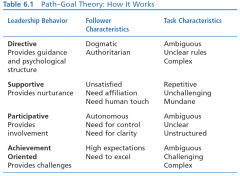
|
|
|
Strengths of Path-Goal Theory |
Useful theoretical framework.Path–goal theory is a useful theoretical framework for understanding how various leadership behaviors affect the satisfaction of followers and their work performance. Integrates motivation. Path–goal theory attempts to integrate the motivation principles of expectancy theory into a theory of leadership. Practical model. Path–goal theory provides a practical model that underscores and highlights the important ways leaders help followers. |
|
|
Criticisms |
Interpreting the meaning of the theory can be confusing because it is so complex and incorporates so many different aspects of leadership; consequently, it is difficult to implement. Empirical research studies have demonstrated only partial support for path–goal theory. It fails to adequately explain the relationship between leadership behavior and worker motivation. The path–goal theory approachtreats leadership as a one-way event in which the leader affects the follower.hem respect for their status |
|
|
Application |
PGT offers valuable insights that can be applied in ongoing settings to improve one’s leadership. Informs leaders about when to be directive, supportive, participative, or achievement oriented. The principles of PGT can be employed by leaders at all organizational levels and for all types of tasks. |
|
|
7. Leader-Member Exchange |
x |
|
|
Leader- Member Exchange |
Some leadership theories focus on leaders: trait approach, skills approach,and behavioral approach Other theories focus on the follower and the context: situational leadership, contingency theory, and path–goal theory. Leader–memberexchange (LMX) theory: conceptualizesleadership as a process that is centered on the interactions between a leaderand followers |
|
|
Leadership |
Leadership is the ability to influence a group of individuals to achieve a common goal. |
|
|
LMX Theory Description |
LMX theory challenges the assumption that leaders treat followers in a collective way, as a group. LMX: Directed attention to the differences that might exist between the leader and each of his/her followers |
|
|
Dimensions of Leadership |
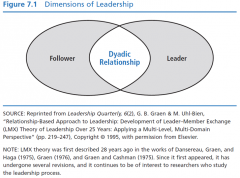
LMX theory makes the dyadic relationship between leaders and followers the focal point of the leadership process |
|
|
Early Studies |
Researchers found two general types of relationships: in-group (High quality relationship) out-group (Low quality relationship) |
|
|
In-group (High quality relationship) |
Expanded/negotiatedrole responsibilities (extra-roles) Relationships marked by mutual trust, respect, liking, and reciprocal influence Receive more information, influence, confidence, and concern than out-group members |
|
|
Out-group (Low quality relationship) |
Formal employment contract (defined-roles) Relationships marked by formal communication based on job descriptions |
|
|
In-Group & Out-Group Followers |
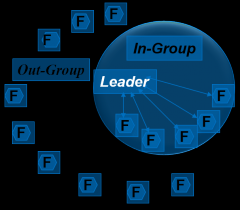
In-Group: more information, influence,confidence, & concern from leader– more dependable, highly involved,& communicative than out-group Out-Group: less compatible with leader; usually just come to work, do the job, & go home |
|
|
Later Studies (Graen & Uhl-Bien, 1995) |
Initial research primarily addressed differences between in-groups and out-groups; later research addressed how LMX theory was related to organizational effectiveness Laterresearch focus on the quality of leader - member exchanges resulting in positive outcomes for: Leaders Followers Groups Organizationsin general |
|
|
Later Studies |
Gerstner and Day (1997) LMX consistently related to member job performance, overall satisfaction,supervisor satisfaction, commitment, role conflict and clarity, turnover intentions. Support for psychometric properties of LMX Questionnaire Ilies,Nahrang,and Morgeson(2007) Meta-analysis of 51 research studies Positive relationship between LMX quality and citizenship behaviors (discretionary employee behaviors that go beyond the prescribed role, job description, or reward system. |
|
|
Researchers found that high-quality leader–member exchanges resulted in: |
Better job attitudes, Job satisfaction Greater participation More desirable work assignments Higher frequency of promotions Less employee turnover More positive performance evaluations Greater organizational commitment More attention and support from the leader Faster career progress |
|
|
On the quality of leader–member exchanges resulting in positive outcomes for: |
Leaders Followers Groups Organizations in general |
|
|
Leadership Making (Graen & Uhl-Bien, 1995) |
A prescriptive approach to leadership that emphasizes that a leader should develop high-quality exchanges with all of her or his followers, rather than just a few. Three phases of leadership making which develop over time: a) stranger phase b) acquaintance phase c) mature partnership phase |
|
|
Phrases in Leadership Making |

Relationships develop from series of exchanges or interactions: Phase1: Role-taking member enters organization leader assesses member’s abilities/talents Phase 2: Role-making informal,unstructured negotiation of role Phase3: Role-routinization social exchange pattern emerges becomes routine |
|
|
Leadership Making - Phase 1: Stranger |
- Interactionswithin the leader-follower dyad are generally rule bound - Rely on contractual relationships - Relate to each other within prescribed organizational roles - Experience lower-quality exchanges - Motivesof follower directed toward self-interest rather than good of the group |
|
|
Leadership Making - Phase 2: Acquaintance |
- Beginswith an “offer” by leader/follower for improved career-oriented social exchanges - Testing period for both, assessing whether • the follower is interested in taking on new roles •leader is willing to provide new challenges• - Shiftin dyad from formalized interactions to new ways of relating - Quality of exchanges improves along with greater trust & respect - Less focus on self-interest, more on goals of the group |
|
|
Leadership Making - Phase 3: Mature Partnership |
- Marked by high-quality leader–member exchanges - Experience high degree of mutual trust, respect, and obligation toward each other - Tested relationship and found it dependable - High degree of reciprocity between leaders and subordinates - May depend on each other for favors and special assistance - Highly developed patterns of relating that produce positive - outcomes for both themselves & the organization Partnerships are transformational –moving beyond self-interest to accomplish greater good of the team &organization |
|
|
How Does LMX Theory Work? |
LMX theory works in two ways: It describes leadership and it prescribes leadership In both: the central concept is the dyadic relationship Descriptively: It suggests that it is importantto recognize the existence of in-groups & out-groups within an organization Significant differences in howgoals are accomplished using in-groups vs. out-groups Relevant differences in in-groupvs. out-group behaviors |
|
|
How Does LMX Theory Work? Prescriptively |
Bestunderstood within the Leadership–Making Model (Graen & Uhl-Bien, 1995) Leader forms special relationships with all followers Leader should offer each follower an opportunity for new roles/responsibilities Leader should nurture high-quality exchanges with all followers Rather than concentrating on differences, leader focuses on ways to build trust & respect with all followers, resulting in entire work group becoming an in-group |
|
|
The Black Box of LMX |
The theory doesn't elaborate on strategies on how one can gain access to in-groups if one chooses to do so. The LMX often handles the exchange as a “black box” (Rousseau 2008) |
|
|
Keys to the “black box” |
Social psychologists have suggested that there are two different ways to have an influence. Systematic processing Heuristic processing |
|
|
Keys to the “black box” of LMX: Dual Process Models of Influence |
Systematic processing: Occurs when we concentrate and think deeply about a message we are persuaded by the strength of the arguments It requires the motivation and the ability to think deeply about the message Heuristic processing: Occurs when we don’t think deeply about a message We are persuaded by cues in the message or the situation. Heuristic processing often happens automatically when we lack the motivation or ability to process deeply With heuristic processing, we use shortcuts to come to a decision. |
|
|
Why don't we think deeply about everything? |
It’shard! It’s unpleasant! Some researchers did a study of the electrical patterns of the brain while people performed various activities. The activity with the greatest similarity to deep thinking was when they had people stick their hand in a bucket of ice water. |
|
|
Examples of Systematic Processing and Heuristic Processing |
Examples of Systematic processing (Controlled responding) Logical Persuasion Effective communication Examples of Heuristic processing (“Weapons of Automatic Influence”) Reciprocation Commitment and Consistency Social Proof Liking Authority Scarcity |
|
|
The Reciprocation Principle |
The reciprocation rule says that we should repay, in kind, what another person has provided us The rule is overpowering: Whether we want it or not… future obligations |
|
|
The Reciprocation Principle: Examples |
Gift: You are out for dinner and the waiter gives you a mint with the bill in order to increase your tip amount Concession:your friend asking you for a huge favour and then concedes to a smaller favour that is way more compelling Overpowering: posses awesome strength, producing a yes response to a request because of the feeling of indebtedness |
|
|
The Reciprocation Principle: Strengths |
LMX theory validates our experience of how people within organizations relate to one another and the leader LMX theory is the only leadership approach that makes the dyadic relationship the center piece of the leadership process It is Applicable to all levels of management LMX theory directs our attention to the importance of communication in leadership Solid research foundation on how the practice of LMX theory is related to positive organizational outcomes Large amount of research supports this theory |
|
|
Criticisms |
- In advertently supports the development of privileged groups in the workplace; appears unfair and discriminatory - The basic theoretical ideas of LMX are not fully developed - How are high-quality leader–member exchanges created? - What are the means to achieve building trust, respect, and obligation? What are the guidelines? - Because of various scales and levels of analysis,measurement of leader–member exchanges is being questioned |
|
|
Application |
Applicable to all levels of management and different types of organizations Directs managers to assess their leadership from a relationship perspective Sensitizes managers to how in-groups and out-groups develop within their work units Can be used to explain how CEOs strategically develop special relationships with select individuals in upper management Can be used to explain how individuals create leadership networks at various levels throughout an organization Can be applied in different types of organizations: volunteer, business, education,and government settings |
|
|
8. Influence: Science and Practice |
x |
|
|
Leadership
|
Leadership is the ability to influence a group of individuals to achieve a common goal. Leadership is simply “a process of influence.” |
|
|
Leadership is simply “a process of influence.” |
Social psychologists have suggested that there are two different ways we think about persuasive messages. - Systematic Processing - Heuristic Processing |
|
|
Leadership is simply “a process of influence.” |
Social psychologists have suggested that there are two different ways we think about persuasive messages. - Systematic processing (Controlled Responding) - We will be persuaded by the strength of the arguments - Occurs when we concentrate and think deeply about a message - It is reacting on the basis of in-depth analysis of all available information. - It requiresthe motivation and the ability to think deeply about the message |
|
|
We look at whateveryone else is doing and do the same. Why? |
Judgment heuristics can leave us open to occasional costly mistakes. - Accident investigators from the Federal Aviation Administration have noted that frequently an obvious error made by a flight captain was not corrected by the other crow members and resulted in a crash - Despite the strong personal importance of the issue, the crew members were using the heuristics shortcut “if an expert says so, it must be true” |
|
|
The Power of Fixed-Action Patterns |
- Both Humans and animals have fixed-action patterns. - Fixed –action patterns are complicated sequences of behavior that occur in virtually the same fashion and in the same order every time (WHIRR). - Our fixed-action patterns are initiated when we encounter trigger features. - Trigger features are often one tiny aspect of the total stimulus (CLICK). - Though limited or seemingly insignificant, trigger features are important since they often activate our fixed-action patterns. |
|
|
An example of fixed-action patterns: The Lander, Blank & Chanowitz (1978) study |
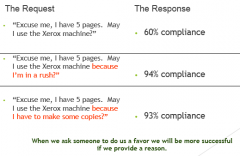
|
|
|
Fixed-Action Patterns |
Two important ideas to remember about fixed-action patterns: - The automatic, fixed-action pattern of response is efficient most of the time. - Humans, like animals, have preprogrammed behavioral response tapes that usually work to our advantage, but trigger features can cause us to activate the tape at the wrong time. |
|
|
Judgment heuristics
|
Form and pace of modern life is not allowing us to make fully thoughtful decision, so we have to take the shortcut. For example, sometimes: - The issue is so complicated - The time is so tight - The distraction is so disturbing - The emotionalarousal is so strong - The mentalfatigue is so deep |
|
|
Judgment heuristics |
- To handle a fast-paced world, we need the mental shortcuts that we have developed overtime. - Judgment heuristics are our shortcuts that allow for simplified thinking. - Our mental shortcuts, stereotypes, or rules of thumb allow us to classify things into groups according to key features. - We are more likely to use our judgment heuristics when we do not have the time, energy,topical interest, or capacity to engage in more purpose thought. - When we process information using judgment heuristics, we often use cues in the message or situation to trigger a decision. - Frequently,our judgment heuristics are efficient and effective, but they can leave us open to occasional costly mistakes. - We will accept their imperfections since there is really no other choice. |
|
|
The contrast principle |
- The contrast principle affects the way we perceive the differences between items that are presented one after the other. - If the item presented second is fairly different from the item presented first, we will tend to perceive it as more different than it is actually. - The contrast principle fits a variety of settings such as: •Lifting a light object first, then a heavy object –the heavy object will feel heavier. •Talking to a very attractive individual, then an unattractive individual – the second will appear more unattractive than if viewed independently. - The great advantage of this principle is that it works consistently as is virtually undetectable. |
|
|
Examples of Judgment heuristics |
- Contrasteffect - Expensive = good (you get what you pay for it) - If an expert said so, it must be true. - Serotypes |
|
|
Leadership is simply “a process of influence.” |
Social psychologists have suggested that there are two different ways we think about persuasive messages. - Systematic processing - Heuristic processing Combination of these two processes forms the Dual Process Models of persuasion. |
|
|
Dual Process Models of persuasion: Examples of Systematic Processing |
Examples of Systematic processing (Controlled responding) - Logical Persuasion - Controlled Exchange |
|
|
Examples of Heuristic processing(Automatic responding, or “Weapons of Automatic Influence”) |
- Reciprocation - Commitment andConsistency - Social Proof - Liking - Authority - Scarcity - Scarcity - Judgment heuristics,stereotypes - Contrasteffect |
|
|
Cialdini’s Six Weapons of Influence |
- Reciprocation - Commitment and Consistency - Social Proof - Liking - Authority - Scarcity |
|
|
The Profiteers |
- We may not clear understand our automatic patterns of behavior, but the fact that they exist makes us vulnerable to people who do know how they function. - Within the animal world, there are organisms that copy the trigger features of other animals in an attempt to trick other animals into manifesting correct behaviors at inappropriate times or in inappropriate ways. These organisms are called mimics. - Mimics exploit inappropriate behaviors of other animals for their own benefit. - A human mimic, or individual who knows the weapons of automatic influence and who employs them expertly to get what they want is called a profiteer. |
|
|
Jujitsu |
- Jujitsu is a Japanese martial art form. - To use this form of combat, personal strength is used minimally to engage the opponent. - Instead, the power naturally present in principles such as gravity, leverage, momentum, and inertia are used to defeat a physically stronger rival. - Profiteers use the power present within the weapons o fautomatic influence against their targets while exerting little personal force. - The lack of personal force expended allows profiteers to manipulate others without the appearance of manipulation. - Even the victims tend to view their compliance natural rather than as a manipulation. |
|
|
Weapons of Influence |
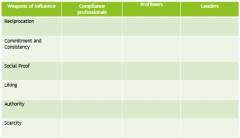
- Ethical leaders try to influence a group of individuals to achieve a common goal. - Compliance professionals have the ability to produce an automatic, mindless compliance from people, that is,a willingness to say yes without thinking. - Profiteers are individuals who know the weapons of automatic influence and who employ them expertly to get what they want. |

